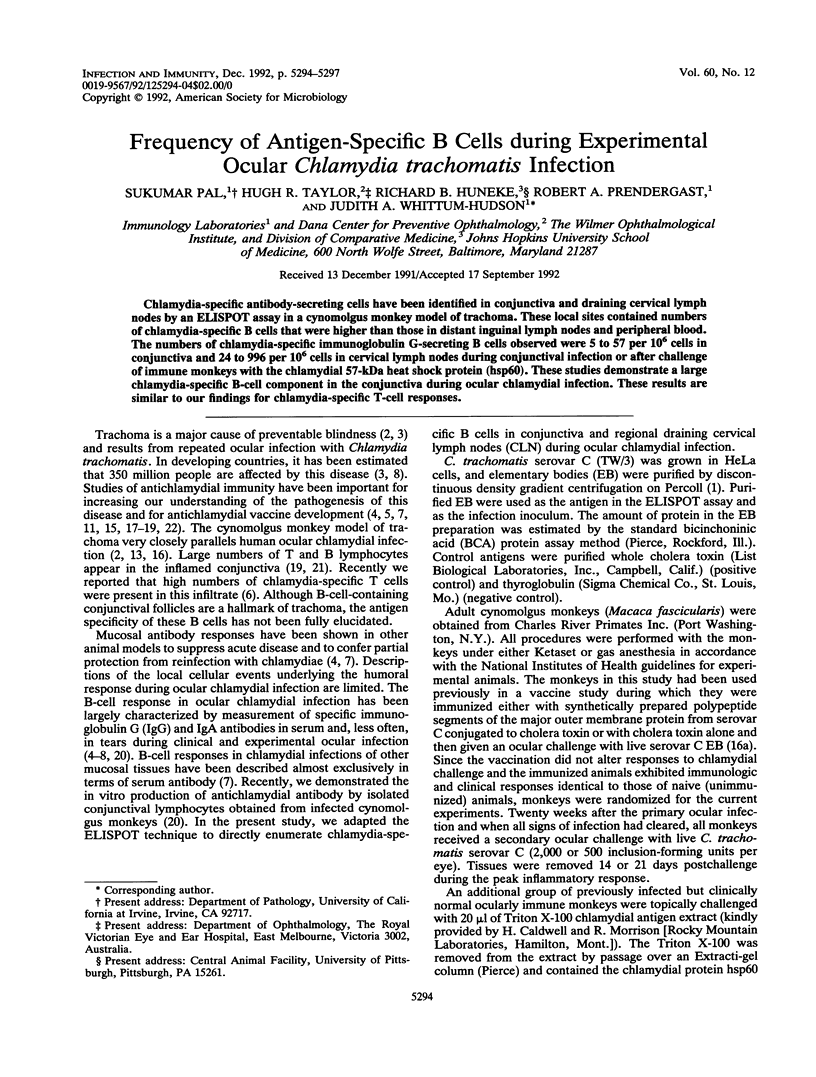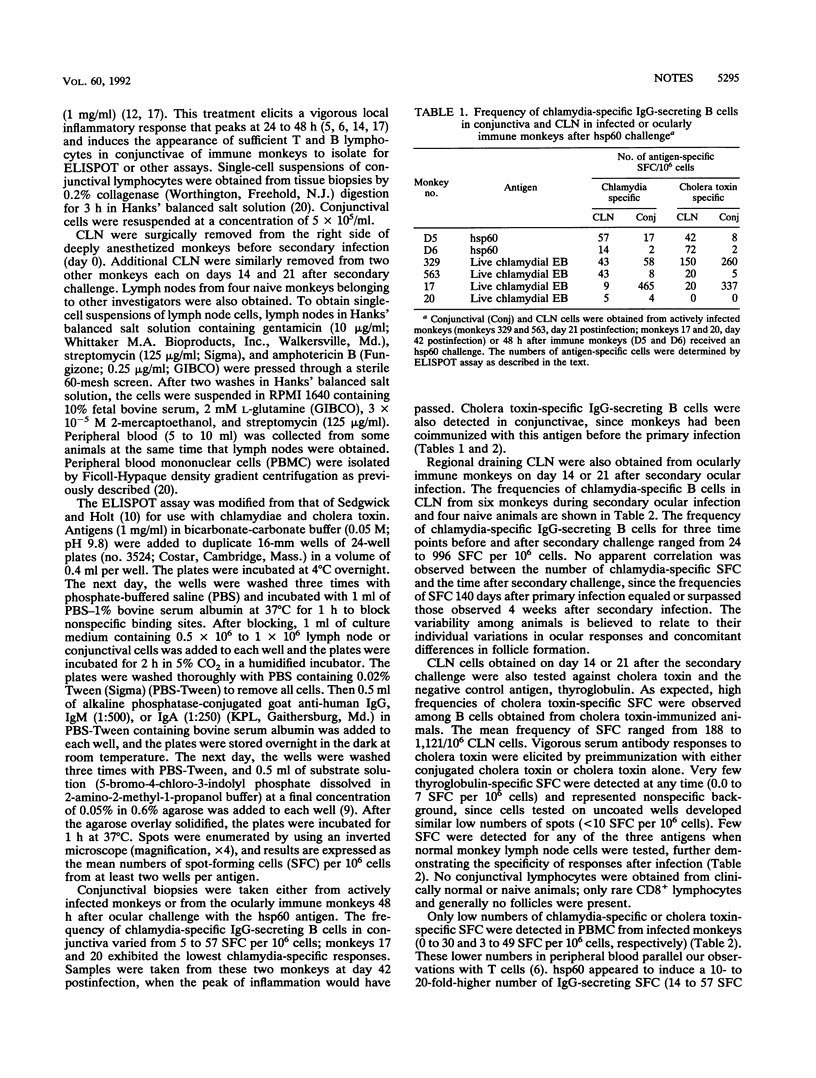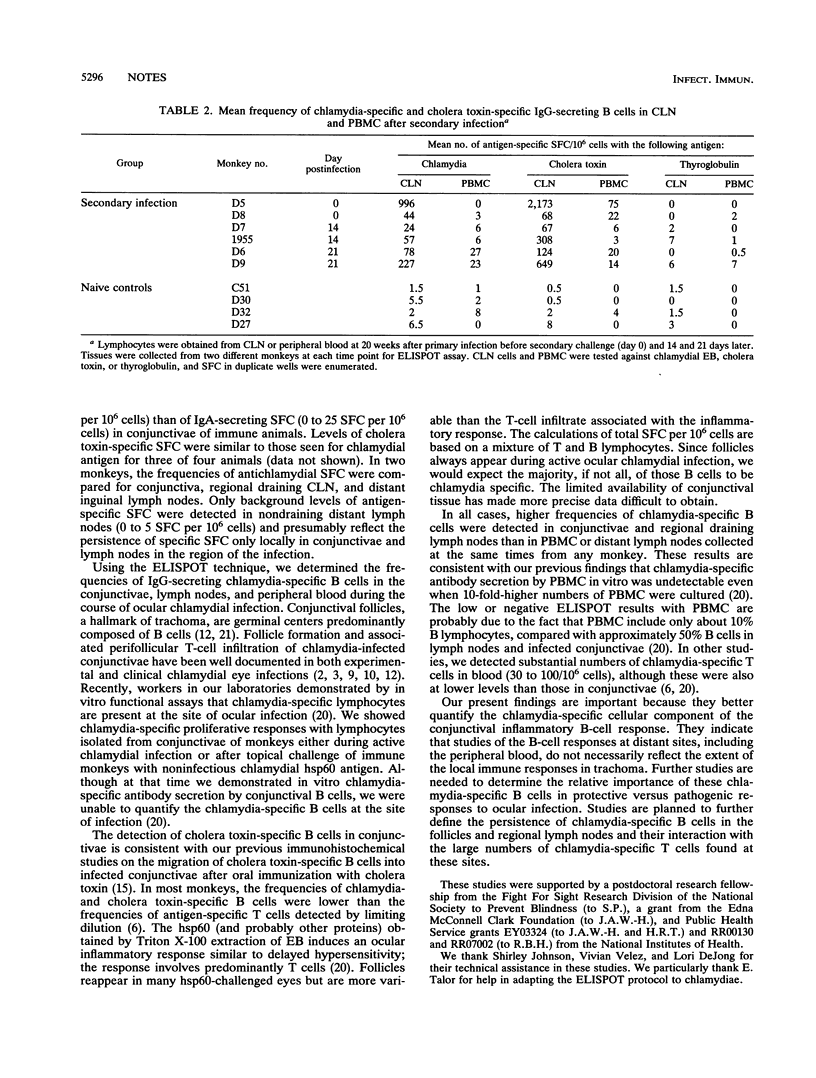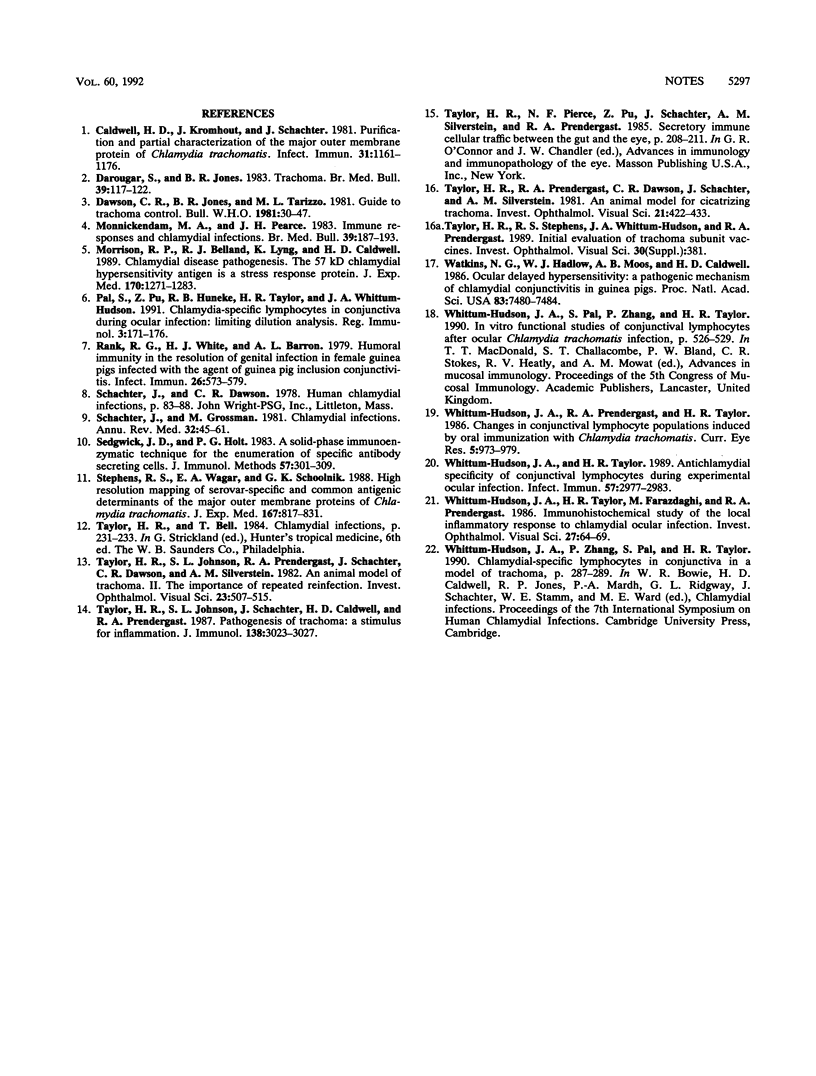Abstract
Chlamydia-specific antibody-secreting cells have been identified in conjunctiva and draining cervical lymph nodes by an ELISPOT assay in a cynomolgus monkey model of trachoma. These local sites contained numbers of chlamydia-specific B cells that were higher than those in distant inguinal lymph nodes and peripheral blood. The numbers of chlamydia-specific immunoglobulin G-secreting B cells observed were 5 to 57 per 10(6) cells in conjunctiva and 24 to 996 per 10(6) cells in cervical lymph nodes during conjunctival infection or after challenge of immune monkeys with the chlamydial 57-kDa heat shock protein (hsp60). These studies demonstrate a large chlamydia-specific B-cell component in the conjunctiva during ocular chlamydial infection. These results are similar to our findings for chlamydia-specific T-cell responses.
Full text
PDF



Selected References
These references are in PubMed. This may not be the complete list of references from this article.
- Caldwell H. D., Kromhout J., Schachter J. Purification and partial characterization of the major outer membrane protein of Chlamydia trachomatis. Infect Immun. 1981 Mar;31(3):1161–1176. doi: 10.1128/iai.31.3.1161-1176.1981. [DOI] [PMC free article] [PubMed] [Google Scholar]
- Darougar S., Jones B. R. Trachoma. Br Med Bull. 1983 Apr;39(2):117–122. doi: 10.1093/oxfordjournals.bmb.a071801. [DOI] [PubMed] [Google Scholar]
- Monnickendam M. A., Pearce J. H. Immune responses and chlamydial infections. Br Med Bull. 1983 Apr;39(2):187–193. doi: 10.1093/oxfordjournals.bmb.a071814. [DOI] [PubMed] [Google Scholar]
- Morrison R. P., Belland R. J., Lyng K., Caldwell H. D. Chlamydial disease pathogenesis. The 57-kD chlamydial hypersensitivity antigen is a stress response protein. J Exp Med. 1989 Oct 1;170(4):1271–1283. doi: 10.1084/jem.170.4.1271. [DOI] [PMC free article] [PubMed] [Google Scholar]
- Pal S., Pu Z., Huneke R. B., Taylor H. R., Whittum-Hudson J. A. Chlamydia-specific lymphocytes in conjunctiva during ocular infection: limiting dilution analysis. Reg Immunol. 1990;3(4):171–176. [PubMed] [Google Scholar]
- Rank R. G., White H. J., Barron A. L. Humoral immunity in the resolution of genital infection in female guinea pigs infected with the agent of guinea pig inclusion conjunctivitis. Infect Immun. 1979 Nov;26(2):573–579. doi: 10.1128/iai.26.2.573-579.1979. [DOI] [PMC free article] [PubMed] [Google Scholar]
- Schachter J., Grossman M. Chlamydial infections. Annu Rev Med. 1981;32:45–61. doi: 10.1146/annurev.me.32.020181.000401. [DOI] [PubMed] [Google Scholar]
- Sedgwick J. D., Holt P. G. A solid-phase immunoenzymatic technique for the enumeration of specific antibody-secreting cells. J Immunol Methods. 1983 Feb 25;57(1-3):301–309. doi: 10.1016/0022-1759(83)90091-1. [DOI] [PubMed] [Google Scholar]
- Stephens R. S., Wagar E. A., Schoolnik G. K. High-resolution mapping of serovar-specific and common antigenic determinants of the major outer membrane protein of Chlamydia trachomatis. J Exp Med. 1988 Mar 1;167(3):817–831. doi: 10.1084/jem.167.3.817. [DOI] [PMC free article] [PubMed] [Google Scholar]
- Taylor H. R., Johnson S. L., Prendergast R. A., Schachter J., Dawson C. R., Silverstein A. M. An animal model of trachoma II. The importance of repeated reinfection. Invest Ophthalmol Vis Sci. 1982 Oct;23(4):507–515. [PubMed] [Google Scholar]
- Taylor H. R., Johnson S. L., Schachter J., Caldwell H. D., Prendergast R. A. Pathogenesis of trachoma: the stimulus for inflammation. J Immunol. 1987 May 1;138(9):3023–3027. [PubMed] [Google Scholar]
- Taylor H. R., Prendergast R. A., Dawson C. R., Schachter J., Silverstein A. M. An animal model for cicatrizing trachoma. Invest Ophthalmol Vis Sci. 1981 Sep;21(3):422–433. [PubMed] [Google Scholar]
- Watkins N. G., Hadlow W. J., Moos A. B., Caldwell H. D. Ocular delayed hypersensitivity: a pathogenetic mechanism of chlamydial-conjunctivitis in guinea pigs. Proc Natl Acad Sci U S A. 1986 Oct;83(19):7480–7484. doi: 10.1073/pnas.83.19.7480. [DOI] [PMC free article] [PubMed] [Google Scholar]
- Whittum-Hudson J. A., Prendergast R. A., Taylor H. R. Changes in conjunctival lymphocyte populations induced by oral immunization with Chlamydia trachomatis. Curr Eye Res. 1986 Dec;5(12):973–979. doi: 10.3109/02713688608995179. [DOI] [PubMed] [Google Scholar]
- Whittum-Hudson J. A., Taylor H. R. Antichlamydial specificity of conjunctival lymphocytes during experimental ocular infection. Infect Immun. 1989 Oct;57(10):2977–2983. doi: 10.1128/iai.57.10.2977-2983.1989. [DOI] [PMC free article] [PubMed] [Google Scholar]
- Whittum-Hudson J. A., Taylor H. R., Farazdaghi M., Prendergast R. A. Immunohistochemical study of the local inflammatory response to chlamydial ocular infection. Invest Ophthalmol Vis Sci. 1986 Jan;27(1):64–69. [PubMed] [Google Scholar]


